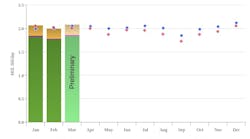So just what did January’s record warmth do to the US natural gas market? Quite a bit, according to Federal Energy Regulatory Commission economists. “January was the warmest in the full 112 years tracked by the National Oceanic and Atmospheric Administration, or NOAA. Temperatures averaged 8.5° above norms,” said Steve Harvey, FERC’s deputy director of market oversight and assessment, in his monthly briefing to commission members on Feb. 16.
A NOAA map of the Lower 48 shows how widespread the warm weather was: Fifteen Northern Plains, Great Lakes, and Upper Midwest states had their warmest January in 112 years. Twenty-six others had above-average temperatures. Citing Federal Reserve estimates, Harvey indicated that the result was a 15% drop in US gas demand from December to January. The record January warm spell followed the ninth warmest November and a roughly average December. “In all, this winter’s extraordinary weather and the resulting weak energy demand has resulted in gas market conditions we certainly couldn’t have predicted in the fall,” said Harvey.
Beyond weather
He also suggested that more than warm temperatures reduced gas demand. Consumers may have responded to much higher November and December gas bills by lowering their thermostats and taking other conservation actions, he said.
Producers, meanwhile, apparently responded to higher gas prices by drilling more wells. Harvey said on Feb. 16 that weekly rig counts “surged recently to record highs not seen since the 1980s.”
He cited “Gas Market Fundamentals,” a report that Bentek Energy LLC in Golden, Colo., released a week earlier, which found “continental US production is dramatically responding to the current high price environment.” Basins reporting the biggest production increases were Fort Worth (17%), Uinta-Piceance (16%), East Texas (11%), Arkla (10%), and Wind River (6%), Bentek’s report said.
Harvey said the basins that the Bentek report identifies as showing growth are “significantly smaller than the Gulf Coast production, but their combined effects are material.”
Without Hurricanes Katrina and Rita, he added, 2005’s US gas production would have increased 2.7% from 2004’s total.
Since Feb. 16
Has this onshore production growth stayed strong since Feb. 16? “If anything, it’s more so,” responded Porter Bennett, president of Bentek Energy and principal author of the report Harvey cited. The number of US rigs drilling for gas in the week ended Feb. 24 was down by five from the previous week’s record of 1,327, according to Baker Hughes Inc. But it still was 232, or 21%, more than a year earlier.
As he was gathering information recently for a new report on western US gas activity, Bennett told OGJ on Feb. 27: “I was startled by the increased production out of the Green River and Uinta-Piceance basins. I don’t expect that to change for the next 6 months, at least. Even if prices soften, it won’t be so much that it hurts drilling programs.” ✦
